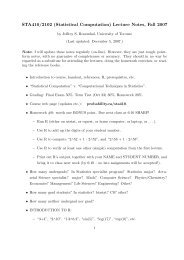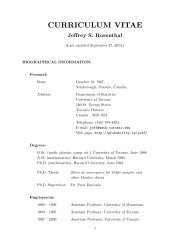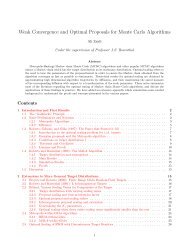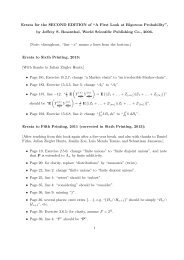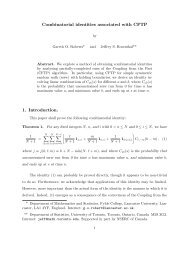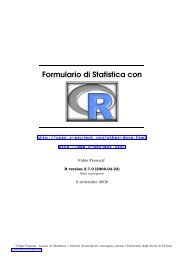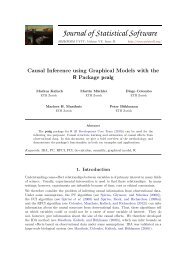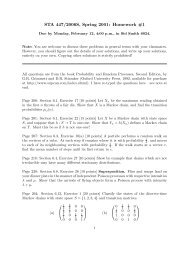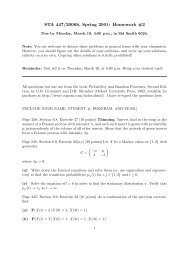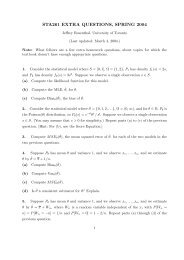Package 'extRemes' - What are R and CRAN?
Package 'extRemes' - What are R and CRAN?
Package 'extRemes' - What are R and CRAN?
Create successful ePaper yourself
Turn your PDF publications into a flip-book with our unique Google optimized e-Paper software.
24 devd<br />
Value<br />
independently noted later by meteorologist A. F. Jenkins (1955). It enjoys theretical support for<br />
modeling maxima taken over large blocks of a series of data.<br />
The generalized P<strong>are</strong>o df is given by (Pick<strong>and</strong>s, 1975)<br />
PrX 0, scale > 0, <strong>and</strong> x > threshold. If shape = 0, then the GP<br />
df is defined by continuity <strong>and</strong> becomes<br />
F(x) = 1 - exp(-(x - threshold)/scale).<br />
There is an approximate relationship between the GEV <strong>and</strong> GP df’s where the GP df is approximately<br />
the tail df for the GEV df. In particular, the scale parameter of the GP is a function of the<br />
threshold (denote it scale.u), <strong>and</strong> is equivalent to scale + shape*(threshold - location) where scale,<br />
shape <strong>and</strong> location <strong>are</strong> parameters from the “equivalent” GE Vdf. Similar to the GEV df, the shape<br />
parameter determines the tail behavior, where shape = 0 gives rise to the exponential df (light tail),<br />
shape > 0 the P<strong>are</strong>to df (heavy tail) <strong>and</strong> shape < 0 the Beta df (bounded upper tail at location -<br />
scale.u/shape). Theoretical justification supports the use of the GP df family for modeling excesses<br />
over a high threshold (i.e., y = x - threshold). It is assumed here that x, q describe x (not y = x -<br />
threshold). Similarly, the r<strong>and</strong>om draws <strong>are</strong> y + threshold.<br />
See Coles (2001) <strong>and</strong> Reiss <strong>and</strong> Thomas (2007) for a very accessible text on extreme value analysis<br />
<strong>and</strong> for more theoretical texts, see for example, Beirlant et al. (2004), de Haan <strong>and</strong> Ferreira (2006),<br />
as well as Reiss <strong>and</strong> Thomas (2007).<br />
’devd’ gives the density function, ’pevd’ gives the distribution function, ’qevd’ gives the quantile<br />
function, <strong>and</strong> ’revd’ generates r<strong>and</strong>om deviates for the GEV or GP df depending on the type argument.<br />
Note<br />
There is a similarity between the location parameter of the GEV df <strong>and</strong> the threshold for the GP df.<br />
For clarity, two separate arguments <strong>are</strong> emplyed here to distinguish the two instead of, for example,<br />
just using the location parameter to describe both.<br />
Author(s)<br />
Eric Gillel<strong>and</strong><br />
References<br />
Beirlant, J., Goegebeur, Y., Teugels, J. <strong>and</strong> Segers, J. (2004) Statistics of Extremes: Theory <strong>and</strong><br />
Applications. Chichester, West Sussex, Engl<strong>and</strong>, UK: Wiley, ISBN 9780471976479, 522pp.<br />
Coles, S. (2001) An introduction to statistical modeling of extreme values, London, U.K.: Springer-<br />
Verlag, 208 pp.<br />
de Haan, L. <strong>and</strong> Ferreira, A. (2006) Extreme Value Theory: An Introduction. New York, NY, USA:<br />
Springer, 288pp.<br />
Jenkinson, A. F. (1955) The frequency distribution of the annual maximum (or minimum) of meteorological<br />
elements. Quart. J. R. Met. Soc., 81, 158–171.



